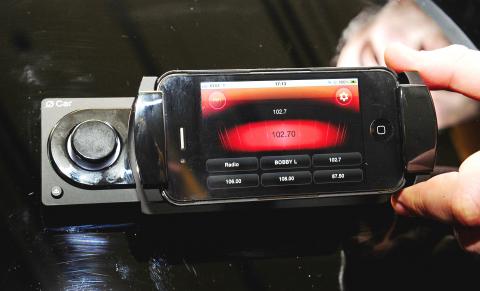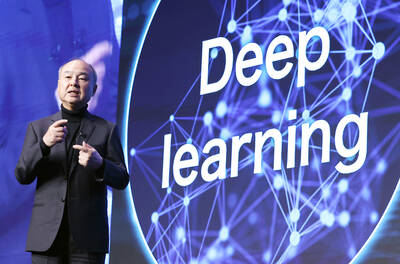As the top US consumer electronics trade show prepares to open this week, organizers are forecasting that global gadget sales may top US$1 trillion this year for the first time ever.
The Consumer Electronics Association (CEA) said on Tuesday that worldwide annual spending on mobile phones, computers, television sets and other items is expected to rise 10 percent this year to US$964 billion.
“We may very well hit the trillion mark,” said Steve Koenig, director of industry analysis for CEA, organizer of the annual Consumer Electronics Show (CES), which opens in Las Vegas today.

PHOTO: AFP
“I’m bullish,” Koenig told reporters. “That number is truly within reach.”
Sales of smartphones, touchscreen tablet computers, electronic book readers and flat-panel LCD television sets are among the items expected to power the industry to record heights.
Many of the latest devices will be on display on the sprawling show floors at the Las Vegas Convention Center, where the four-day event is expected to attract more than 125,000 visitors from around the world and 2,600 exhibitors.
The CEA said it expected consumer electronics sales to grow by 23 percent in Western Europe this year and 15 percent in both North America and China.
Growth for Asia — excluding China and Japan — was forecast at 12 percent.
Consumer electronics sales were expected to increase by 10 percent in South America, 8 percent in Japan, 7 percent in Africa, 5 percent in Eastern Europe and 4 percent in the Middle East.
Consumer electronics sales increased 13 percent last year to US$873 billion after falling 9 percent in 2009 in the depths of the recession.
CEA chief economist Shawn Dubravac said smartphones and tablet computers like Apple’s popular iPad were expected to be among the hottest items this year.
“The standard handset is a declining market,” Dubravac said. “All the growth you see is in smartphones.”
The CEA forecast that tablet computer sales would double this year over last year to around 30 million units while e-readers such as Amazon’s Kindle would ring up sales of about 20 million units worldwide.
“Tablets will be one of the key themes at this year’s show,” Dubravac said, as technology -companies seek to emulate the success of Apple’s iPad.
“I wouldn’t be surprised if we saw 100-plus tablets at CES,” he said, adding that the optimal price point for the devices appears to be around US$350.
The CEA said mobile computers — which include tablets — would account for US$220 billion in total personal computer sales of US$316 billion this year, with desktop computers accounting for the remaining US$96 billion.
Web-connected televisions are expected to see continued growth with the CEA forecasting that 52 percent of TV sets sold in 2014 would allow users to access the Internet.
Just 9 percent, or 3.2 million, of the TV sets sold last year were Internet-enabled, according to the CEA, a figure expected to jump to 15 percent, or 5.2 million, this year.
While Web-connected TVs are expected to take off and LCD TV sales are forecast to remain strong, 3D television sets have yet to catch on, in part because they are still considered to be too expensive, Dubravac said.
He added that an emerging trend across devices — from smartphones to tablet computers to TV sets — was the increasing popularity of the dedicated mini-programs known as applications.
“Apps are huge,” he said.
Half of all mobile device owners use applications, according to a CEA study, with communications, weather, maps, music, news, games and social networking among the most popular.
“We’ll see a lot more shopping apps,” CEA senior research analyst Ben Arnold said. “Apps that empower consumers.”

IN THE AIR: While most companies said they were committed to North American operations, some added that production and costs would depend on the outcome of a US trade probe Leading local contract electronics makers Wistron Corp (緯創), Quanta Computer Inc (廣達), Inventec Corp (英業達) and Compal Electronics Inc (仁寶) are to maintain their North American expansion plans, despite Washington’s 20 percent tariff on Taiwanese goods. Wistron said it has long maintained a presence in the US, while distributing production across Taiwan, North America, Southeast Asia and Europe. The company is in talks with customers to align capacity with their site preferences, a company official told the Taipei Times by telephone on Friday. The company is still in talks with clients over who would bear the tariff costs, with the outcome pending further

NEGOTIATIONS: Semiconductors play an outsized role in Taiwan’s industrial and economic development and are a major driver of the Taiwan-US trade imbalance With US President Donald Trump threatening to impose tariffs on semiconductors, Taiwan is expected to face a significant challenge, as information and communications technology (ICT) products account for more than 70 percent of its exports to the US, Chung-Hua Institution for Economic Research (CIER, 中華經濟研究院) president Lien Hsien-ming (連賢明) said on Friday. Compared with other countries, semiconductors play a disproportionately large role in Taiwan’s industrial and economic development, Lien said. As the sixth-largest contributor to the US trade deficit, Taiwan recorded a US$73.9 billion trade surplus with the US last year — up from US$47.8 billion in 2023 — driven by strong

A proposed 100 percent tariff on chip imports announced by US President Donald Trump could shift more of Taiwan’s semiconductor production overseas, a Taiwan Institute of Economic Research (TIER) researcher said yesterday. Trump’s tariff policy will accelerate the global semiconductor industry’s pace to establish roots in the US, leading to higher supply chain costs and ultimately raising prices of consumer electronics and creating uncertainty for future market demand, Arisa Liu (劉佩真) at the institute’s Taiwan Industry Economics Database said in a telephone interview. Trump’s move signals his intention to "restore the glory of the US semiconductor industry," Liu noted, saying that

AI: Softbank’s stake increases in Nvidia and TSMC reflect Masayoshi Son’s effort to gain a foothold in key nodes of the AI value chain, from chip design to data infrastructure Softbank Group Corp is building up stakes in Nvidia Corp and Taiwan Semiconductor Manufacturing Co (TSMC, 台積電), the latest reflection of founder Masayoshi Son’s focus on the tools and hardware underpinning artificial intelligence (AI). The Japanese technology investor raised its stake in Nvidia to about US$3 billion by the end of March, up from US$1 billion in the prior quarter, regulatory filings showed. It bought about US$330 million worth of TSMC shares and US$170 million in Oracle Corp, they showed. Softbank’s signature Vision Fund has also monetized almost US$2 billion of public and private assets in the first half of this year,